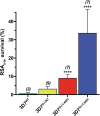Indigenous emergence and spread of kelch13 C469Y artemisinin-resistant Plasmodium falciparum in Uganda
- PMID: 39028193
- PMCID: PMC11304714
- DOI: 10.1128/aac.01659-23
Indigenous emergence and spread of kelch13 C469Y artemisinin-resistant Plasmodium falciparum in Uganda
Abstract
Artemisinin-based combination therapies (ACTs) were introduced as the standard of care for uncomplicated malaria in Africa almost two decades ago. Recent studies in East Africa have reported a gradual increase in kelch13 (k13) mutant parasites associated with reduced artesunate efficacy. As part of the Community Access to Rectal Artesunate for Malaria project, we collected blood samples from 697 children with signs of severe malaria in northern Uganda between 2018 and 2020, before and after the introduction of rectal artesunate (RAS) in 2019. K13 polymorphisms were assessed, and parasite editing and phenotyping were performed to assess the impact of mutations on parasite resistance. Whole-genome sequencing was performed, and haplotype networks were constructed to determine the geographic origin of k13 mutations. Of the 697 children, 540 were positive for Plasmodium falciparum malaria by PCR and were treated with either RAS or injectable artesunate monotherapy followed in most cases by ACT. The most common k13 mutation was C469Y (6.7%), which was detected more frequently in samples collected after RAS introduction. Genome editing confirmed reduced in vitro susceptibility to artemisinin in C469Y-harboring parasites compared to wild-type controls (P < 0.001). The haplotypic network showed that flanking regions of the C469Y mutation shared the same African genetic background, suggesting a single and indigenous origin of the mutation. Our data provide evidence of selection for the artemisinin-resistant C469Y mutation. The realistic threat of multiresistant parasites emerging in Africa should encourage careful monitoring of the efficacy of artemisinin derivatives and strict adherence to ACT treatment regimens.
Keywords: Uganda; artemisinin resistance; k13; malaria; rectal artesunate.
Conflict of interest statement
The authors declare no conflict of interest.
Figures



References
-
- 2015. Guidelines for the treatment of malaria. 3rd ed. World Health Organization, Geneva. https://www.afro.who.int/publications/guidelines-treatment-malaria-third.... - PubMed
-
- Mairet-Khedim M, Leang R, Marmai C, Khim N, Kim S, Ke S, Kauy C, Kloeung N, Eam R, Chy S, Izac B, Mey Bouth D, Dorina Bustos M, Ringwald P, Ariey F, Witkowski B. 2021. Clinical and in vitro resistance of Plasmodium falciparum to artesunate-amodiaquine in Cambodia. Clin Infect Dis 73:406–413. doi:10.1093/cid/ciaa628 - DOI - PMC - PubMed
-
- Straimer J, Gnädig NF, Witkowski B, Amaratunga C, Duru V, Ramadani AP, Dacheux M, Khim N, Zhang L, Lam S, Gregory PD, Urnov FD, Mercereau-Puijalon O, Benoit-Vical F, Fairhurst RM, Ménard D, Fidock DA. 2015. Drug resistance. K13-propeller mutations confer artemisinin resistance in Plasmodium falciparum clinical isolates. Science 347:428–431. doi:10.1126/science.1260867 - DOI - PMC - PubMed
Publication types
MeSH terms
Substances
Grants and funding
LinkOut - more resources
Full Text Sources
Research Materials

